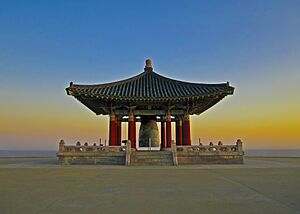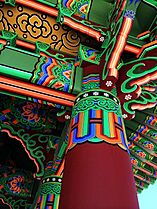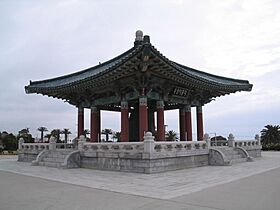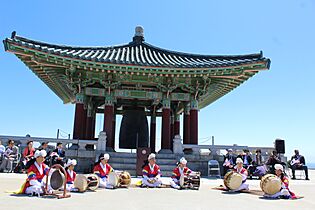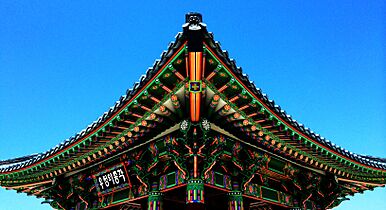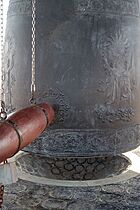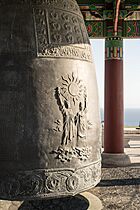Korean Bell of Friendship facts for kids
| Korean Bell of Friendship | |
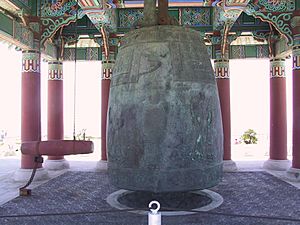 |
|
Quick facts for kids Korean name |
|
|---|---|
| Hangul |
우정의 종
|
| Hanja |
友情의 鐘
|
| Revised Romanization | Ujeong-ui Jong |
| McCune–Reischauer | Ujŏng'ŭi Chong |
| Designated: | May 3, 1978 |
| Reference #: | 187 |
The Korean Bell of Friendship (more commonly called Korean Friendship Bell) is a massive bronze bell housed in a stone pavilion located in Angel's Gate Park, situated in the San Pedro neighborhood of Los Angeles, California. Positioned at the intersection of Gaffey and 37th Streets, this section of the park is also referred to as the "Korean–American Peace Park" and occupies a portion of the former Upper Reservation of Fort MacArthur.
Description
The Korean Friendship Bell is modeled after the Divine Bell of King Seongdeok the Great of Silla (also known as the Emille Bell), The Emille Bell was cast in 771 for Bongdeok Temple and is currently housed at the National Museum of Gyeongju. Designated as National Treasure of Korea number 29 in 1962, the Emille Bell holds historical significance. It is noteworthy that the Emille Bell is the largest bell ever cast in Korean history, and both the Emille Bell and the Korean Friendship Bell are among the largest bells in the world.
The bell is made of over seventeen tons of copper and tin, with gold, nickel, lead, and phosphorus added to the alloy for tone quality. It has a circumference of 7.25 m (23.8 ft), diameter of 7+1⁄2 ft (2.3 m), average thickness of 8 in (200 mm), and a height of 3.63 m (12 ft). The exterior surface is richly decorated in relief, featuring four pairs of figures. Each pair includes a "Goddess of Liberty" (bearing some resemblance to the Statue of Liberty) and a Seonnyeo, or Korean spirit figure, holding the South Korean national symbol: a Taegeuk symbol, a branch of rose of Sharon, a branch of laurel, and a dove.
History
The bell was presented by the South Korean government to the United States to celebrate the bicentennial of the U.S. and to symbolize friendship between the two countries. The effort was coordinated by Philip Ahn, a Korean American actor. It was dedicated on October 3, 1976, and declared Los Angeles Historic-Cultural Monument No. 187 on May 3, 1978.
The bell is struck 13 times on the first Saturday of each month at 11:30 AM.
Beginning in 2010, the bell has been ceremonially struck five times a year:
- Dec 31: New Year's Eve
- Jan 13: Korean American Day
- Jul 4: Fourth of July
- Aug 15: Korean Liberation Day
- Sep 17: Constitution Day
It was also rung on September 11, 2002, to commemorate the first anniversary of the September 11, 2001, terrorist attacks. The bell does not have a clapper; instead, it is sounded by striking it with a large wooden log.
The pavilion that houses the bell, known as the Belfry of Friendship, was built by South Korean craftsmen over a period of ten months. Its design is traditional. It is axially symmetric, consisting of a hipped (a.k.a. "pyramidal") roof supported by twelve columns representing the Korean zodiac, each column guarded by a carved animal. The color patterning along the bell's pavilion is known in Korean as dancheong.
In 2013, the bell received a full restoration to remove accumulated rust and graffiti tagging, and access to the bell and the pavilion was restricted from September through December. The City of Los Angeles rededicated the Bell during a public ceremony on January 10, 2014, after the Korean Ministry of Culture, Sports and Tourism contributed more than US$300,000 (equivalent to $371,000 in 2022) to hire bell masters for the restoration.
Access to the Bell was closed for more than a year following the start of the COVID-19 pandemic in Los Angeles, reopening in May 2021.
See also
 In Spanish: Campana Coreana de la Amistad para niños
In Spanish: Campana Coreana de la Amistad para niños
- History of the Korean Americans in Los Angeles
- Koreatown, Los Angeles
- List of Los Angeles Historic-Cultural Monuments in the Harbor area


